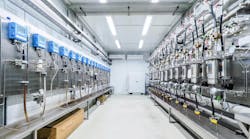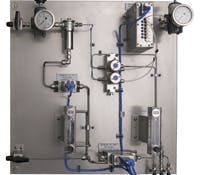Process analyzer performance can benefit from access to information on the state of the sample conditioning system. Such systems can suffer from incorrect temperature, restricted flow, improper phase control, etc. These failings can result in delivery of an inadequate or inconsistent sample to the analyzer and, thus, can undermine the accuracy of a measurement.
Fortunately, development of a standard related to NeSSI (the New Sampling/Sensor Initiative) to foster adoption of miniature modular sampling systems now extends to communication between components of the sample system and an analyzer or controller. The second sub-standard of ANSI/ISA76.00.02, "NeSSI Generation II — Smart Systems and Communications Bus," defines a communication structure that enables the sample conditioning system to evolve from a mechanical component in the field requiring physical monitoring to a control element providing feedback for the benefit of the process.
The implementation of the ISA standard should spur the availability of more hardware to measure the sample system's pressure, temperature and flow as well as to control flow, etc., in the size and ranges needed for NeSSI systems. Importantly, the sub-standard is independent of the form factor specified by ANSI/ISA 76.00.02 and, thus, can be applied to components mounted in a traditional tube-and-fitting sampling system.
THE IMPLICATIONS
A sample conditioning system that can communicate to the process analyzer the temperature, pressure, flow, valve position, etc., will allow the analyzer to determine if the current analysis has value or should be aborted. In turn, the analyzer can immediately notify the system controller of suspect analytical information. This notification clearly has value. In addition, it provides wider benefits with significant value by helping users achieve:
- greater confidence in analyzer values,
- better reliability for process measurements, and
- lower total cost of ownership, and deal with
- increased staff workloads due to attrition, and
- decreased availability of skilled labor.
The confidence operators have in the values being reported by process analyzers directly impacts their operational decisions. A system that can advise whether or not the analytical values could be suspect should substantially affect the acceptance of the values being reported.Information available from the process analyzer's sample conditioning system could improve staff utilization efficiency. It could allow a plant to perform maintenance as required instead of the more-traditional maintenance by schedule. The notification that a filter element requires replacing can enable staff to take action before plugging occurs, improving reliability and also reducing the cost of ownership. A sample conditioning system that can advise when maintenance is necessary or, better yet, provide information for predicting maintenance demands may eliminate the need to schedule rounds.
Staffing a location with analyzer technicians or mechanics isn't a simple task. These positions require a broad mix of skills. Suitable people are relatively scarce and the loss of experienced personnel is making matters worse. This is taking a toll on the efficiency of maintenance efforts. Up-skilled analytical systems in the field that can help diagnose themselves will ease maintaining the systems.
SPECIALIZED SUPPORT
While up-skilling the sample conditioning systems offers benefits, it doesn't eliminate the need for personnel with suitable skills. The solution often is to employ specialized outside support, as needed, to evaluate the performance or provide periodic inspections of a process analyzer. Such specialists can add a new dimension to a group's ability to manage its workload.
These experts can tap into information provided from the sample-conditioning-system components and periodic validations of measurement performance — either locally or via a secure remote connection — to assess the accuracy and reliability of a measurement system. Examples of this type of support include:
- periodically evaluating the performance of a sensor using statistically derived data to establish the expected accuracy and precision of the process measurement,
- using a measured parameter to determine the need for a maintenance activity such as changing a gas cylinder, and
- determining how long a filter may be left in service before it adversely affects measurement performance.
Transitioning to the ANSI/SP 76.00.02 standard provides an impetus to look beyond what has been considered good enough; however, the evolution might require a cultural change. Up-skilling a sample conditioning system incurs costs but, as already noted, can lead to very significant benefits.
Adding components to a sample conditioning system that communicate back to the analyzer turns the system from basically a dumb field element to a control element. The feedback provides the information required to implement logic-based schema that can validate the analytical information significant to the process.
However, not every system can justify the additional components. Cost, system complexity and environmental limitations — as well as the creation of another potential point of failure — can rule out an upgrade. Each system must be evaluated on its own merits.
Up-skilling the sample conditioning system can support planned maintenance, provide information for predictive maintenance, improve the reliability of analytical data, and even enable the analyzer to serve as a primary safety device. Minor improvements in each of these categories will have net positive impact on the overall cost of ownership.ANSI/ISA76.00.02, "NeSSI Generation II – Smart Systems and Communications Bus," provided the catalyst to develop the technology to make sample conditioning systems intelligent and, thus, allow use of advanced maintenance concepts. Adding another dimension to the sample conditioning system will permit a broader view into the performance of the analytical measurement. It's up to each of us to explore and decide what works best for our processes.
MICHAEL HOFFMAN is business development manager, solutions process analytics, for Siemens Industry, Houston. E-mail him at [email protected].



